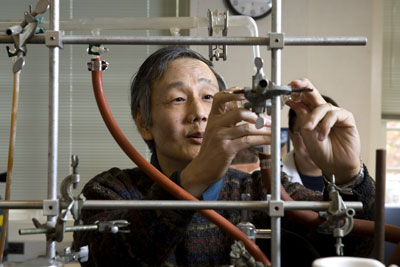Intercampus research team develops artificial skin, heart valves and blood vessels
By Claudia Wheatley

A high-functioning artificial artery that the human body will accept as its own is on its way, says Cornell fiber scientist C.C. Chu. He works on three of the eight projects funded by the Morgan Seed Grants for Collaborative Multidisciplinary Research in Tissue Engineering, which promote intercampus collaboration between scientists in Ithaca and at Weill Cornell Medical College.
Chu's projects are to develop artificial skin, produce artificial heart valves and craft a blood vessel graft.
"To create the perfect artery that could be taken off the shelf and sewn into patients would have a tremendous impact on the longevity and quality of life for patients all around the world," said Weill Cornell vascular surgeon K. Craig Kent, a collaborator.
Cardiovascular disease accounts for one in three American deaths each year. Most patients die from clogged arteries that can't maintain adequate blood supply to vital organs. Current treatment forces the affected artery open and then replaces it with a metallic stent, an artificial graft or one of the patient's own veins. But artificial arteries are subject to blood clotting and don't function very well in the heart or below the knee. As many as 50 percent of patients don't have healthy veins to spare -- and all three approaches could lead to the blood vessels narrowing again.
Chu, the Rebecca Q. Morgan '60 Professor of Fiber Science and Apparel Design in the College of Human Ecology, an expert on biodegradable biomaterials and tissue engineering, has more than 50 patents stemming from his work. His biodegradable biomaterials have applications for the treatment of wounds, diseased heart valves and blood vessels, bone repair, gene transfection for gene therapy and even immunotherapy for cancer patients.
"[Chu] had developed these really fascinating polymers, and we had intense interest in arteries, in vascular biology," said Kent, noting that the collaboration also includes Bo Liu, associate research professor of cell biology in surgery at Weill Cornell, and Cynthia Reinhart-King, assistant professor of biomedical engineering in the College of Engineering, whose research focuses on cells that line the inside of blood vessels. "Chu was just what we needed, and we were just what he needed, to bring this all together."
"My research focuses on the treatment of life-threatening diseases and accidents through the lens of biomaterials and medical devices, and it's naturally multidisciplinary," Chu said. The vascular graft team's goal is to replace an artificial artery that's been in use since 1958. Chu's graft sample is designed to act temporarily as a scaffold to which blood vessel cells will adhere, ultimately regenerating a new, natural artery. Its biomaterial would also actively participate in the wound healing after surgery and eventually be absorbed by the body.
Post honors Chu's fiber science research
The College of Human Ecology hosted a dedication ceremony Jan. 27 to mark the newly endowed Rebecca Q. Morgan '60 Professor of Fiber Science and Apparel Design, the first professorship in that discipline.
Morgan, a former Cornell trustee and currently co-chair of the university's Major Gifts Committee, funded the professorship with the goal of supporting new developments in fiber science and encouraging cross-disciplinary research.
In July, the Cornell Board of Trustees appointed Professor C.C. Chu, an international expert in fiber science, to the position."It's truly a great honor," Chu said. "It allows me to pursue my goal, which is to use biomaterials to help improve and save human lives."
Morgan said at the ceremony that it is her honor to support such cutting-edge research. "I believe we are going to have some discoveries that will improve the health and well-being of people," Morgan said. "I'm very grateful for the opportunity to make this kind of impact."
The materials used to build that scaffold are derived from a family of amino acid-based polymeric biomaterials called polyester amides (PEA) that were developed in Chu's lab and have been engineered and fabricated into fibers; 3-D microporous gels; micro- and nanospheres; or electrospun fabric membranes. They can be positively, negatively or neutrally charged; they can be hydrophilic or hydrophobic.
"We developed this drug-eluting fibrous membrane, and Weill Cornell surgeons implanted it into a pig for a second-degree burn trial," Chu said. "It worked out beautifully and healed wound tissue faster and better than a commercial product." Another device he works on is for bone generation; yet another is a drug-eluting stent that Cornell licenses to a company to develop biodegradable coatings. Chu also has developed a new gel biomaterial intended to carry interleukin 12 for immunotherapy of cancer and that can be engineered to carry also vaccines and cells.
His artery graft is a tubular biomaterial that has a nitric oxide derivative, which keeps a natural blood vessel dilated. Having an artificial blood vessel with built-in nitric oxide could have the potential to ward off a re-narrowing of the blood vessel, which has been the Holy Grail in cardiovascular research for decades, Chu said. Preliminary data from a test involving the graft in a rat are encouraging; two weeks later, the blood vessel walls surrounding the new graft showed no sign of thickening.
"The animal trial data illustrate the need for multidisciplinary synergism among collaborators," Chu said. "They are exciting, tangible results from the Morgan seed grants."
For Kent and Chu, one good collaboration led to another. Now the team also is exploring the use of the same polymer in human gene therapy.
"Medical schools and graduate and undergraduate schools don't collaborate that much, yet when they do, the potential benefits to medical research are tremendous," Kent said.
Claudia Wheatley is a writer with the Office of Publications and Marketing. This is an abridged version of the article originally published in Human Ecology magazine.
Media Contact
Nicola Pytell
Get Cornell news delivered right to your inbox.
Subscribe